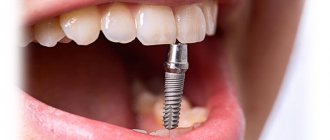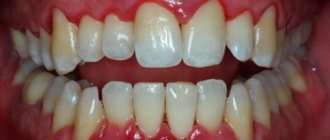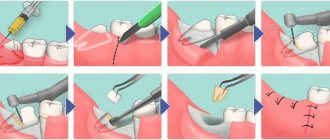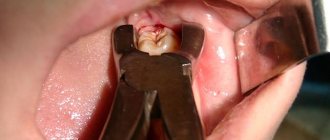- Is it painful to remove subgingival calculus?
- Is it painful to remove tartar from periodontal disease?
- Will my teeth hurt after the procedure?
- Why is tartar dangerous?
- Prevention of tartar
The choice of one or another treatment method depends on the complexity of the problem and the stage of its development.
By clicking the “request a call” button you agree to the personal data processing policy.
The main question that interests everyone who has been recommended to clean the stones on their teeth is how painful it is. In most cases, visiting the dentist is always associated with unpleasant sensations and the expectation of pain. Although modern dentistry offers many methods of effective anesthesia and the latest treatment methods with minimal trauma.
Important. Go to brush your teeth boldly and without fear. We guarantee that after the first procedure you will brush your teeth constantly.
How to do professional ultrasonic cleaning
Until about 10-15 years ago, dentists removed hard plaque using curettes. These are hand tools, very sharp and sharpened at the ends. It is clear that the procedure was painful and injured the enamel and gums. The layer of “living” tissue that is removed with curettes is 5-25 microns. This means that each time the enamel becomes thinner and becomes more and more sensitive.
During gentle ultrasonic cleaning, only 0.1 microns of tissue is removed. It is carried out using an ultrasound machine, which is now installed in almost every dentistry and clinic. A special scaler attachment produces silent vibration vibrations with a frequency of 16 - 45 thousand Hz. The doctor adjusts the amplitude of vibrations to remove different types of plaque, including in hard-to-reach places.
Ultrasonic waves eliminate not only visible yellow plaque, but also subgingival bacterial deposits that accumulate in periodontal pockets and trigger the inflammatory process.
Ultrasound, like a drill, crushes tartar into tiny particles. The resulting stone dust is removed using a mouth “vacuum cleaner”, then the enamel is washed with a stream of water. At the very end, the surface of the teeth is ground and polished using professional nylon brushes and abrasive pastes. The entire session lasts about 30-40 minutes. And if there are too many stones, the procedure takes about an hour.
Does it hurt to clean stones on your teeth?
The specific sensations of a particular patient depend on the method of cleaning the stone on the teeth and the individual sensitivity of the person. Everyone's pain threshold is different, so you shouldn't rely on other people's reviews. What may seem intolerable to someone else will remind you of a mosquito bite and vice versa.
Important. When choosing a method for removing stones from teeth, listen to your doctor’s recommendations. The dentist makes a decision based on the results of the examination - the condition of the enamel, the amount of deposits, predisposition or the presence of diseases such as periodontal disease and periodontitis.
Ultrasonic cleaning
Hard dental deposits can only be removed using an ultrasonic scaler. Under the influence of ultrasonic waves, the stones completely crumble, while the enamel remains intact. The procedure is practically painless, but with increased sensitivity, discomfort may occur. In this case, the doctor uses special anesthesia.
A slight pain may also occur when treating gum pockets. But the feeling is quite tolerable and lasts literally a fraction of a second. Ultrasonic cleaning is the only possible way to remove hard stones from pockets, and you should not refuse to do it. It is better to warn your doctor before the procedure that you have increased tooth sensitivity.
When treating areas with enamel, that is, the teeth themselves, pain, as a rule, does not occur.
The main advantages of the method include:
- ideal cleaning quality - the enamel becomes smooth and even;
- the ability to remove hard deposits from interdental spaces and hard-to-reach places;
- bactericidal effect - pathogenic microflora dies under the influence of ultrasonic waves, which reduces the risk of caries;
- optical effect - after removing brown spots and stripes, the enamel becomes visually lighter.
The procedure for removing tartar is mandatory before prosthetics, implantation, before installing braces, and other orthopedic manipulations. Hygienic cleaning with a scaler is also indicated in cases of periodontal disease and periodontitis, twice a year. In other cases, it is recommended to remove tartar with ultrasound once every 12 months.
The duration of the procedure depends on the condition of the patient’s teeth, but, as a rule, does not exceed 40-60 minutes. In especially severe cases, the doctor performs cleaning over several visits.
There are contraindications:
- severe heart disease, the presence of a pacemaker - the ultrasonic wave can disrupt the rhythm of the heart or the device;
- pregnancy - ultrasonic cleaning can negatively affect the development of the fetus, and also lead to miscarriage or premature birth;
- increased pathological sensitivity of the enamel - here we are talking not so much about the pain syndrome, but about the reaction of the body as a whole;
- rehabilitation period after operations and infectious diseases.
Another risk factor is childhood. You can remove stones from your teeth no earlier than two years after the last tooth erupts.
Important. It is not possible to remove hard plaque from teeth at home. In fact, the stone grows into the pores of the enamel, and even the hardest toothbrush is not able to remove it.
Laser removal
From a pain point of view, the procedure is considered completely painless. The laser beam completely destroys hard and soft deposits without affecting the enamel. Dentists recommend removing tartar with a laser in cases where cleaning of the gum pockets is not required. Perhaps this is the only drawback of the procedure.
After laser cleaning, the enamel becomes smoother, its resistance to external influences increases, and the likelihood of caries, gingivitis, and stomatitis decreases. The procedure takes no more than an hour. The main indication for laser stone removal is the presence of hard plaque on the teeth.
There are a number of contraindications - pregnancy, postoperative period, decreased immunity, infectious diseases. These also include untreated caries, a large number of fillings, and increased sensitivity of tooth enamel.
Laser stone removal is an expensive procedure.
Air-Flow
The procedure involves cleaning teeth from stone using a water-dispersed mixture under pressure. Small crystals remove soft plaque from the enamel, while simultaneously polishing it. The main advantage of the technique is a high degree of teeth cleansing even in the most difficult to reach places, including gum pockets.
Air-Flow is traditionally used in combination as a subsequent step after ultrasonic cleaning. As a result, teeth are completely cleaned of hard and soft deposits. The teeth become smooth, as if polished.
The special advantages of the method include:
- painlessness - the patient does not experience discomfort even with very sensitive enamel;
- excellent result - interdental spaces, gum pockets are perfectly cleaned, pigmentation is eliminated;
- natural whitening – by removing stains, teeth become one or two shades lighter;
- hypoallergenic - the mixture contains water, fine-crystalline soda, citrus fragrance.
The effect is especially noticeable for those who have orthopedic structures installed in their mouths - crowns, braces, veneers, implants. The procedure is also recommended for regular use by smokers and lovers of strong tea and coffee.
Removing stones from teeth using this method is contraindicated:
- patients with respiratory diseases - to avoid a possible attack;
- with thin enamel and pathological sensitivity of teeth;
- with caution during pregnancy.
The procedure is carried out in 30-40 minutes, while the patient experiences a feeling of comfort, which is facilitated by a light massage of the gums.
Complete cleaning of teeth and interdental pockets reduces the risk of caries to a minimum.
Chemical removal
It is also possible to clean off old tartar chemically - this method is now used extremely rarely, only in cases where ultrasound and air flow are powerless. A composition containing chemically active substances is applied to the enamel. Under their influence, the stone softens and is cleaned manually.
The method is painless, but is not recommended for thin enamel, increased tooth sensitivity and the presence of open carious cavities.
The second name of the procedure is chemical bleaching. The enamel becomes lighter by 3-4 tones.
Mechanical cleaning
The procedure is extremely unpleasant and is now practically not used anywhere. Hard tartar and soft plaque are removed with special metal spatulas. During the manipulation, there is a high risk that the doctor’s hand may slip and the instrument may damage the gums. The effectiveness of the method is in question, since it is not possible to completely remove deposits.
Pros and cons of ultrasonic cleaning
The method is excellent for the prevention of caries and inflammatory gum diseases - gingivitis, periodontitis, stomatitis. It is recommended for all patients. This is why ultrasonic teeth cleaning has become so popular and in demand:
- safe removal of tartar without damaging the enamel;
- removal of subgingival plaque, which causes bleeding and inflammation of the gums;
- Ultrasound sterilizes the tooth surface and destroys pathogenic microflora;
- eliminating bad breath;
- lightening the enamel to a natural shade - by 1-2 tones.
Dry cleaning
For professional hygiene, a special gel containing acid and hydrogen is applied to the teeth. The composition is kept for several minutes. Under the influence of chemicals, tartar is destroyed. It is then easily cleaned off with water.
The technique is painless and effective, but plaque in the interdental spaces cannot be removed in this way. The composition also has an adverse effect on the gums, so it is better not to use it for people with closely located vessels.
Mechanical teeth cleaning
The simplest method of professional dental hygiene. It is carried out using dental instruments, highly active pastes and brushes. This takes longer than other cleaning methods. There is a risk of damage to the enamel. Therefore, the mechanical method is used quite rarely.
Fluoridation of teeth
After professional cleaning, teeth are often fluoridated. It performs 4 functions:
- strengthens enamel;
- reduces tooth sensitivity;
- slows down the growth of bacteria;
- reduces the negative impact of an acidic environment.
To do this, the surface of the teeth is coated with fluoride varnish. To do this, use a special brush or mouth guard with gel.
Care after ultrasonic teeth cleaning
After the procedure, a feeling of freshness and cleanliness appears, the enamel brightens, becomes perfectly smooth, and pleasant to the touch. To maintain the results as long as possible, it is recommended to carefully care for your teeth, brushing them after every meal or at least 2 times a day.
On the first day, slight sensitivity is possible, so it is better to avoid foods that are too cold or hot. It is also recommended to limit the intake of coloring products (coffee, tea, wine) for a couple of days so that the whiteness of the enamel will please you for a long time.
Dentists advise purchasing a new toothbrush. After ultrasound treatment, the gums are slightly irritated and vulnerable to infection. And your old brush can serve as a source of harmful bacteria.
Dental and oral hygiene in dentistry: why is it so important to undergo the procedure regularly?
The main task of oral hygiene is to remove hard and soft plaque from the surfaces of the teeth, as well as other areas and areas of the mouth.
Regular and timely removal of dental plaque will be the best prevention of caries and other dental diseases. In addition, oral hygiene in dentistry contributes to:
- Formation of healthy strong teeth;
- Complete destruction of harmful microorganisms that live in large numbers in the human oral cavity;
- Prevention of periodontal and gastrointestinal diseases.
Professional dental and oral hygiene helps keep your teeth enamel in excellent condition - after brushing, your teeth become whiter and your smile looks attractive! Professional oral hygiene is especially recommended for people with bad habits: smokers, patients who abuse strong tea and coffee. The procedure is also indicated for people with poor immunity, because often malfunctions in the body’s immune system are expressed precisely in the appearance of caries and inflammation in the oral cavity.
Regular dental hygiene will ultimately result in significant savings on dental treatment costs.
Which is inevitable if the teeth are not properly cared for and are covered with a thick layer of plaque. So, professional oral hygiene is certainly not a waste of time and money; on the contrary, it is a valuable investment in your own health!
Contraindications to ultrasonic teeth cleaning
Although ultrasonic teeth cleaning is recommended for all patients, there are still contraindications:
- cardiac arrhythmia and other serious ailments of the cardiovascular system;
- presence of a pacemaker;
- chronic asthma, bronchitis;
- exacerbation of any respiratory diseases;
- serious infectious diseases - hepatitis, tuberculosis;
- childhood and adolescence.
Unfortunately, ultrasonic cleaning is not suitable for patients who have dental implants and orthopedic structures in the mouth. The fact is that vibrations of ultrasonic waves can disrupt the integrity of some products. This happens extremely rarely, but still not worth the risk. In this case, an alternative method is used - Air Flow abrasive cleaning.
Stages of the procedure
Professional sanitation of the oral cavity is carried out in stages.
Stage 1: Comprehensive inspection
It is performed using modern instruments to identify deposits and assess the condition of tissues.
Stage 2: removal of soft and hard formations
To obtain high results, two methods are combined: ultrasonic cleaning and Air Flow. The first option destroys the structure of tartar, the second removes plaque and remaining stone.
Stage 3: Polishing
The enamel is polished using special brushes and paste. The surface is smooth and shiny.
Stage 4: fluoridation
To protect bone tissue, a gel or varnish containing a high concentration of fluoride is used.
How do children brush their teeth?
Ultrasonic cleaning and Air Flow are not prescribed for children under 14 years of age. Professional sanitation of the oral cavity is performed using special brushes and paste. After dental treatment, the surface is coated with fluoride-containing gel to strengthen the enamel.
Is it possible to do ultrasonic cleaning at home?
Unfortunately, it is impossible to install a scaler at home and do ultrasonic cleaning of your teeth yourself. This should be done by a specialist. But there is an alternative option - buy an ultrasonic toothbrush. It has a special mechanism and a conductor inside the handle that produce vibrations. This is the so-called “soft ultrasound”, which destroys pathogenic microflora. This device removes plaque 200% more effectively than a regular toothbrush. It’s just that it’s unlikely to be able to cope with massive tartar that has accumulated on your teeth for years. Therefore, it is still recommended to consult a dentist before purchasing.
Application of anesthesia
To completely eliminate pain, our center uses the best drugs from trusted manufacturers. In most cases, Ultracaine is used. If the situation requires it, three-stage anesthesia is performed. To begin with, the gums are treated with lidocaine gel. Then an injection is given, containing a small dose of medicine. After a couple of minutes, the dentist injects the remaining anesthetic. Very fine needles are used.
Often, teeth cleaning at the dentist is performed under local anesthesia. This reliably relieves pain. All that remains is tactile sensitivity. Today, dentists resort to numbing technologies such as patching, which provide superficial anesthesia through sprays or gels. The infiltration method involves injections into the gums. As you can see, hygiene procedures today are actually carried out without fear and pain.
Tartar can only be removed in a clinic
Gradually, the plaque hardens, mineralizes and turns into tartar. In addition to the fact that teeth acquire an unpleasant yellowish tint near the roots, the stone contributes to the growth of soft plaque, potentially increasing the risk of gum pocket inflammation and periodontal disease.
Tartar removal: before and after
While soft plaque is difficult to remove at home, tartar is impossible. Even abrasive pastes, for example, based on salt or coal (these are sold in lines of “natural” cosmetic products), will not affect it in any way.
Laser dental treatment
The latest laser systems have become firmly established in today's medicine; they are also successfully used in dentistry. Laser dental treatment is an opportunity to quickly, and most importantly - without the slightest discomfort and generally without pain, treat caries in the initial stages, treat gum diseases, and carry out whitening and hygiene procedures. The laser has become a real salvation for those people who are afraid to have their teeth treated, because it allows them to undergo treatment without experiencing any fear or pain, even without anesthesia.
A laser beam can be used instead of the notorious dental drill, the mere mention of which may be unpleasant for you - the laser successfully and very carefully removes areas of the tooth affected by caries, while simultaneously disinfecting dental tissues. It is also used instead of a scalpel during implantation, as well as some other dental operations. Unlike a scalpel, the laser beam acts bloodlessly, very accurately and painlessly, while ensuring complete sterility of the surgical field.
Dentist at the 32 Dent clinic Andrey Andreevich Koloskov says: “Our clinic uses the latest laser systems, the work of which many of our patients have already been able to evaluate. Yes, laser dental treatment is more expensive than usual, but for those people who are not too fond of being treated by dentists, it is optimal. Anesthesia is usually not required for this treatment because it does not cause any pain or discomfort.”
Removal process
Depulping or removing a nerve always begins with preparation. To do this, the doctor must conduct a thorough examination of the oral cavity, collect information about the person’s health, and take the necessary tests. Only after this can he begin the nerve removal procedure, which is a simple operation lasting about 1 hour.
The first stage involves the administration of an anesthetic instead of surgery. Its effect begins after about 10 minutes and lasts for 1-2 hours, depending on the dose. General anesthesia, usually in the form of a sleeping gas, may also be used. The action begins literally in 1-3 minutes.
After this, the doctor begins preparing the working area, isolating the tooth from saliva, opening it and other manipulations. Only after this does the nerve extraction procedure begin. It is carried out using a pulp extractor - a dental needle in the form of a spiral. Next, the pulp chamber is filled with an antiseptic, the canals are carefully sealed, a control photograph of the patient’s jaw is taken, and a permanent filling is fixed.
previous post
Is it possible to build up a front tooth?
next entry











